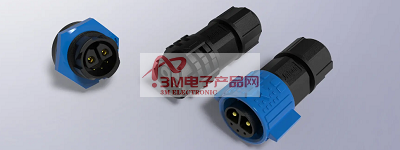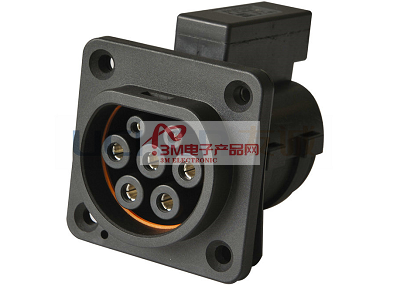Categorization:Product Information
Today, electronic systems in automobiles are clocked at several hundred megahertz, with sub-nanosecond planning for the leading and trailing edges of the pulses used, and sub-nanosecond pixel rates are used for high-quality video circuits. These higher processing speed table clear engineering is constantly challenged. Then how to prevent and deal with the problem of electromagnetic interference in automotive connectors deserve our attention. Circuits on the oscillation rate becomes faster (rise / fall time), voltage / current levels become greater, the problem becomes more. As a result, today, compared with earlier years, dealing with electromagnetic compatibility (EMC) is more difficult. The fast-moving pulse currents that precede the two wave sections of a circuit make it clear that so-called differential mode noise sources, electromagnetic fields around the circuit, can be coupled to other components and intrude into the connected parts. Noise that is rationally or capacitively coupled is common mode interference. RF disturbance currents are identical to each other, and the system can be modeled as consisting of a noise source, a "victim circuit" or "receiver", and a loop (typically a base plate). The magnitude of the disturbance is characterized by a number of factors: the strength of the noise source, the size of the area around the disturbance current, and the rate of change. So, while there is a high probability of undesired disturbances in a circuit, noise is almost always co-modeled. Once a cable is connected between the input/output (I/O) automotive connector and the chassis or ground plane, there are certain RF voltages that present themselves, resulting in a few milliamps of RF current that can be enough to exceed the allowable transmitter frequency.

Noise coupling and conveying common mode noise is produced by irrational planning. Some typical causes are different lengths of individual wires in different pairs, or different distances to the power supply plane or chassis. Another cause is defective components, such as magnetic induction coils with transformers and capacitors with active devices (e.g., by using additional integrated circuits (ASICs)). Magnetic components, especially the so-called "iron core choke" type energy storage inductors, are used in power converters and always generate electromagnetic fields. The air gap in the magnetic circuit is equivalent to a large resistance in a series circuit, where more power is consumed. Therefore, the core choke, wound on a ferrite rod, generates a strong electromagnetic field around the rod and a strong field near the electrodes. In a switching power supply that utilizes a back tracing structure, there must be an empty space on the transformer in which there is a strong magnetic field. The element in which the magnetic field is adhered to fit is the spiral tube, so that the electromagnetic field is distributed along the length of the tube core. This is one of the reasons why spiral structures are preferred for magnetic components operating at high frequencies. Improper decoupling circuits generally become a source of disturbance as well. Assuming that the circuit requires large pulse currents, and that partial decoupling does not guarantee small capacitance or very high internal resistance requirements, the voltage generated by the power supply circuit drops. This corresponds to ripple, or perhaps to a rapid change in voltage between terminals. Due to the stray capacitance of the package, the churn can couple to other circuits and cause common mode problems. When common mode currents contaminate I/O interface circuits, it is necessary to deal with the problem before it passes through the automotive connector. Different applications advocate different ways to deal with this problem. In video circuits, where the I/O signals are single-ended and share the same common circuit, it is important to deal with it by filtering out the noise with a small LC filter. In low-frequency serial interface networks, some stray capacitance is satisfactory to shunt the noise to the baseboard. Differential-drive interfaces, such as Ethernet, are generally coupled to the I/O area via a transformer, which is coupled by center taps supplied on one or both sides of the transformer. These center taps are connected to the base plate via high voltage capacitors that shunt the common mode noise to the base plate so that the signal is not distorted. There is no universal approach to common mode noise in the I/O region for all types of I/O interfaces. Planners' primary concern is to get the circuit right, and often overlook details that are considered sketchy. Some basic rules can make the noise in the early years of the arrival of automotive connectors, down to small: 1) will be decoupling capacitors set in the immediate vicinity of the load. 2) rapid changes in the front and rear edges of the pulse current, the loop specification should be small. 3) so that high-current devices (i.e., drivers and ASICs) away from the I / O ports. 4) Determination of the integrity of the signal to ensure that the overshoot and undershoot is small, especially with regard to the high current of the vital signals (eg. Clock, bus). 5) Apply partial filtering, such as RF ferrite, can absorb RF interference. 6) Supply low impedance lap on the bottom board or in the I / O area of the reference on the bottom board. RF noise and automotive connectors even if engineers choose to use many of the above-listed prevention methods to reduce RF noise in the I / O area, but also can not guarantee that these prevention methods can be successful to meet the requirements of satisfactory emission. Some of the noise is conducted interference, i.e., common mode current activity on the internal circuit board. The source of this disturbance is between the backplane and the circuitry, etc. Therefore, this RF current must travel through a low impedance path (between the backplane and the carrier signal lines). Assuming that the automotive connector does not present a satisfactorily low impedance (at the overlap with the base plate), this RF current moves through the stray capacitance. When this RF current flows through the cable, it inevitably generates emissions. Another mechanism to make the common mode current injected into the I / O area, there is a strong source of interference in the vicinity of the coupling. Even some "shielding" of the automotive connector is useless, because the source of disturbance is in the vicinity of the automotive connector, such as the PC environment. Assuming that there is a gap between the automotive connector and the chassis, the RF voltage induced at this location can degrade the EMC function. Shielding automotive connector methods include, adding finger reeds or spacers. Lapping the automotive connector is filling the empty space between the automotive connector and the chassis. This method requires a gasket. A metal liner is preferable and only needs to be handled suitably, that is, only the surface needs to be free of contamination, only the liner needs to be untouched or damaged by hand and only satisfactory pressure to adhere to good, low impedance contact. Other methods are automotive connector mounted connector tabs or perhaps equipping the automotive connector on the housing. At the moment, the large contact surface is slightly smaller and the specification and elasticity of the joint piece should be strictly controlled. Equipment shielding car connectors, openings in the chassis, the side of the opening to remove oil, to be carefully made, if the tolerance is not suitable, resulting in car connectors in the chassis fall too deep, so that the lap continuous. Every EMC engineer knows that in a "good" system, this issue must be satisfied with the launch requirements, and in the production line in time to check. Untightened or bent pads, equipment in critical areas on the oil, will fail. EMI automotive connectors were selected for the following reasons 1) Conductive foam is extremely soft and can be placed around the entire perimeter of the automotive connector. This eliminates the problems associated with another housing, liner. 2) Mechanical engineers can equip the automotive connector within the tolerances acceptable to the system housing. 3) The automotive connector ends up in a low impedance lap with the housing to ensure superior contact. The liner on the inside of the housing wall can be made of a softer material when it is to be painted with a masking requirement.4) Planning that requires forced cooling, the liner is good for another feature: the seam between the automotive connector and the housing wall should be sealed up to minimize air leakage. In a dusty environment, the liner should play a role in the system to adhere to clean.

2、About 3M electronic products network platform related to the introduction and sales of products briefly: 3M electronic products network - a professional agent / production / sales of a variety of {connectors | wiring harness | wire and cable products }; if you have a related [connectors | wiring harness | wire and cable products] purchasing / sourcing needs or would like to buy / to understand which connectors | wiring harness | wire and cable products we can provide solutions, please contact our business staff below; if you have a related [connectors | wiring harness | wire and cable products] sales / resources and promotion needs, please click "→ Business Cooperation ← with a dedicated person to discuss! If you have related [connector | wire harness | wire and cable production] sales / resources and promotion needs, please click on the "¡¡ Business Cooperation ←" to discuss with a person!